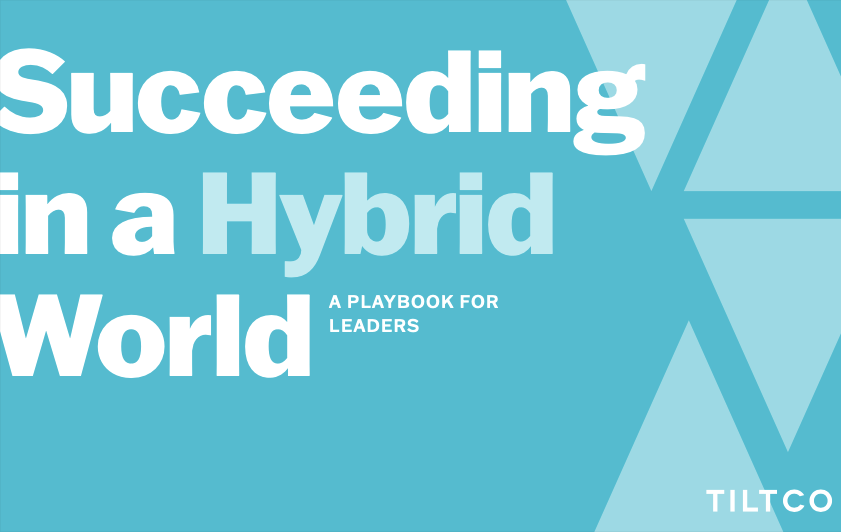How to communicate and engage employees in a hybrid workplace

TILTCO held a series of roundtable discussions in January and February 2021. Attended by business leaders, consultants, academics and experts, the discussions gathered insights and practical ideas to help leaders reimagine their organizations as we emerge from the Covid-19 pandemic.
Remote work was once a job perk for the few. Covid-19 changed that. Now, those who have operated remotely this past year are reconsidering their workplace models as we emerge from the pandemic. For some, the success of remote work has led them to forego returning to a physical office space. Others, however, will likely bring at least some of their workforce back to the physical office.
According to a BCG study, 37% of companies expect that more than 25% of their employees will work in a hybrid model – where there is a mix of remote and in person work happening. Leaders are asking how they can effectively communicate and engage employees in this mixed model. A big takeaway is a basic one: leaders should ensure that all employees feel connected and have a consistent experience – regardless of where they sit.
Before considering how to communicate and engage with employees in a mixed workforce, the Roundtable group – many of whom spent their careers in hybrid environments – agreed that leaders first need to clearly and explicitly define the hybrid model for their team. Sarah Sonnenfeld, principal at Alsephina Consulting, summarized the thinking:
“The companies that think about this really carefully for their populations, ensuring what’s appropriate for specific jobs and the company’s competitive situation, can gain real advantages.”
To do this, there cannot be a one-size-fits-all template for hybrid workplaces. Leaders must carefully consider their context and organization and then set clear parameters for what hybrid means for their organizations. Do they have bifurcated teams – some are always in person and some always remote? Or, do they have a model like the one recently announced by Roland Busch, CEO of Siemens, that enables employees to work from anywhere they feel comfortable “for an average of two to three days a week?”
Changing your workplace model triggers change in communication and engagement practices. The Roundtable Group identified four key practices that leaders can do to more effectively connect with their hybrid teams.
Clearly and intentionally set and communicate new norms for how work gets done
Once a model is selected, John King, managing partner at Special Circumstances Partners, says that to engage with your team you must “be confident that your people understand the norms of the workplace. That is, what you want your company to be and how you want to work together. This is much harder to do if you have different blends of people, and so it is important to think through.”
Building on this idea, Will Bachman, managing partner of Umbrex, encouraged “leaders to be very explicit on action items that are assigned in a remote environment – what is the delivery and when is it due – and have some kind of tracking system that provides visibility.” This transparency could include micro-tactics like the one Rashay Jethalal, an experienced financial services executive suggested: “Define how technologies should be used to communicate on the team by cascading urgency by channel. For example, email if you need something innocuous, slack if you need me within the day or call if you need me right away. It’s very tactical, but important.”
Be mindful and take specific actions to better balance the dynamics on your hybrid teams
A recent Wired article explains that hybrid models create “two fundamentally different employee experiences to manage.” When it comes to communications, then, “leaders will need to ask how we can communicate in a way that feels inclusive for both the people in the office and those working remotely. And, how can we create the same amount of collaboration and sense of ownership across the entire employee base,” explained Phil Arrata, business leader and former CEO of MEC.
Some of this requires leaders to establish and model more inclusive behaviours as well create additional opportunities for conversations to flow outside of formal meeting times. Bernard Borowski, senior advisor at Digital Lean & Data Advantage, calls for leaders to “foster ways of communicating between employees as would happen in the normal office setting.” Continuing, Bernard explained leaders also need to consider what tools to use to capture employee reactions and feedback in order to ensure two-way communications.
Invest in the tools employees need to work productively and connect efficiently – regardless of where they sit
Teams can only be successful if they’re set up for success. To enable remote work, leaders need to evaluate their overall technology suite to ensure it facilitates work across various settings and makes communicating in multiple ways easy for leaders and teams.
According to Melanie Espeland, CEO and executive voice coach at Espeland Enterprises, individual equipment is also needed to optimize the remote work experience: “Things as simple as your at-home set up, access to a high-end microphone or speaker, and good lighting can change the experience for the individual speaking as well as others listening. Practically, that means leaders must proactively provide individuals with the proper equipment.”
Be intentional in how you build personal connection
The hybrid model doesn’t necessarily allow remote employees to have those fly-by hallway interactions that can build camaraderie and connection between leaders and employees. This could be seen as a disadvantage, but Agnes Kunkel, host of The 2023 Podcast: Your window to the world beyond Covid-19, offers another point of view: “It’s not the distance between the leader and the employee, but it is the attitude of the leader.” She goes on to explain that leaders need to be sure they’re making the most of their time by cutting down large meetings, using tools to encourage collaboration and brainstorming, and investing more time in one-on-one meetings.
Leaders will also need to invest more at the personal level to ensure relationships are nurtured equally across onsite and remote employees. Being mindful and creative in their efforts to understand what every individual is working on, facilitate interconnection between work efforts, assess what support is required, and most importantly, check in on how they are doing – personally and professionally.
Listen in to our upcoming LeaderLab Podcast that shares more insights and perspectives from this Roundtable. And stay tuned for insights from our second roundtable that will focus on how leaders can effectively support their middle managers to lead in a hybrid environment.
Interested in learning more?
Here are links to a few resources that we’ve appreciated as we prepared for our Roundtables:
- Wired: Hybrid Remote Work Offers the Worst of Both Worlds
- Inc: This Company’s New 2 Sentence Remote Work Policy is the Best I’ve Ever Heard
- McKinsey: What’s next for Remote Work?
- BCG: Remote Work? Where Do We Go From Here?

Download the Leader Playbook to access practical insights and ideas that will help you be a better leader in a hybrid context.
We thank our guests for their time and insights: Phil Arrata, Will Bachman, Bernard Borowski, Melanie Espeland, Rashay Jethalal, John King, Agnes Kunkel, Sarah Sonnenfeld.
A special thank you to Will Bachman and Umbrex for their help in bringing these roundtables together.